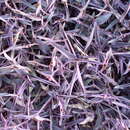en
names in breadcrumbs


Tradescantia pallida is a species of spiderwort (a genus of New World plants) similar to T. fluminensis and T. zebrina. The cultivar T. pallida 'Purpurea' is commonly called purple secretia, purple-heart,[2] or purple queen.[3] It is native to the Gulf Coast region of eastern Mexico. Edward Palmer collected the type specimen near Ciudad Victoria, Tamaulipas in 1907.[4][5]
The Latin specific epithet pallida means "pale".[6]
Tradescantia pallida is an evergreen perennial plant of scrambling stature. It is distinguished by elongated, pointed leaves - themselves glaucous green, sometimes fringed with red or purple - and bearing small, sterile three-petaled flowers of white, pink or purple. Plants are top-killed by moderate frosts, but will often sprout back from roots.[7]
The cultivar T. pallida 'Purpurea' has purple leaves and pink flowers.
Widely used as an ornamental plant in gardens and borders, as a ground cover, hanging plant, or - particularly in colder climates where it cannot survive the winter season - houseplant, it is propagated easily by cuttings (the stems are visibly segmented and roots will frequently grow from the joints).
As a houseplant, T. pallida has been judged exceptionally effective at improving indoor air quality by filtering out volatile organic compounds, a class of common pollutants and respiratory irritants, an effect known as phytoremediation.[8]
Numerous cultivars are available, of which 'Purpurea' with purple foliage has gained the Royal Horticultural Society's Award of Garden Merit.[9][10]
Tradescantia pallida is a species of spiderwort (a genus of New World plants) similar to T. fluminensis and T. zebrina. The cultivar T. pallida 'Purpurea' is commonly called purple secretia, purple-heart, or purple queen. It is native to the Gulf Coast region of eastern Mexico. Edward Palmer collected the type specimen near Ciudad Victoria, Tamaulipas in 1907.